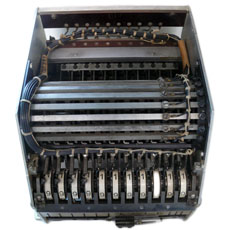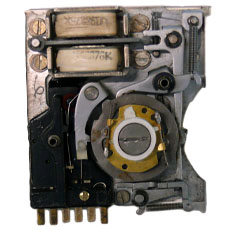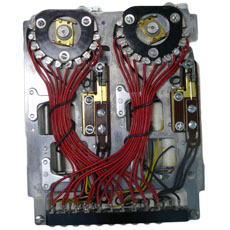In this case we are dealing with an 11-digit, decimal, electromechanical block computer unit (1920 - 1935) with a cycle time of 600 ms. The add carry for all four basic arithmetic operations is mechanical stored and performed. The engine is synchronized by card reader of tabulating machine or calculating punch as well as tabulating machine printing mechanism. The electromagnets are electric driven with a direct voltage of 110 volt.

This exhibit shows a monadic, decimal, electromechanical arithmetic unit, which was used in the mainframe ASCC, also known as Harvard Mark I. The computer was developed by Howard H. Aiken in cooperation with IBM. It was finished in 1943 and used for the first time in 1944. The computer consisted of 700.000 components, 80km of wires, had a length of 15m and a height of 2,5m and multiplied two numbers in a time of six seconds. It worked fully in the decimal system, which was represented amongst others by such arithmetic units. The ten carry mechanism in this unit was saved mechanically and executed electromechanically. Using a gear drive it synchronized with other components of the computer and later was used in the calculating punch or the tabulating machine. This arithmetic unit had a cycle time of 333ms and its electromagnets were actuated with a voltage of 40 Volts.

The shown object is a Double-digit decimal electromechanical arithmetic unit with a cycle time of 400ms. The electrical unit of the exhibit could calculate arithmetic operation of two given operands. In this case there would be a carry. This problem is solved by the mechanical unit of the exhibit. Gears are used for this. Based on this it is possible to connect up twenty of this arithmetic unit. The electromagnet, that are used here, runs with voltage of 40V and they are good for controlling the gears. You could extend this electromechanical arithmetic unit with a card reader or a printing mechanism to automatically get data in and out of it.
